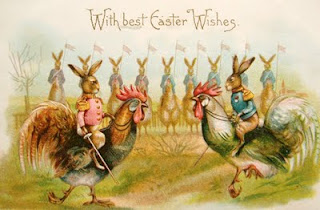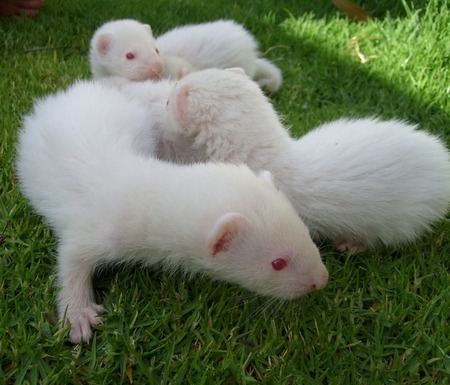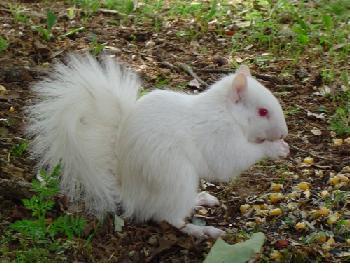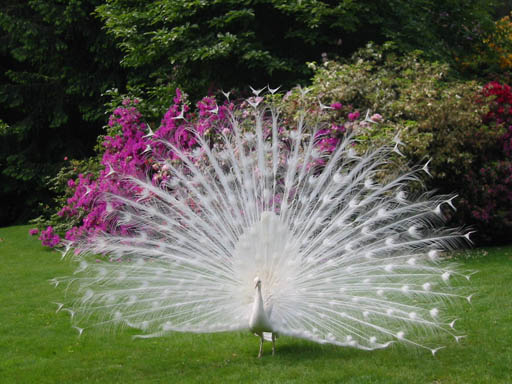|
|
|---|
Friday, April 29, 2011
A lot of people got up in the middle of the night to watch the Royal Wedding, but we didn't. We just kept on sleeping. If there had been any dogs in the wedding, it might have been worth watching, but there weren't, so it wasn't. Or at least that's what I think!
We don't know if the Royal Newlyweds have any dogs, or what kind of dogs they even like. Prince William's grandmother, Queen Elizabeth II, likes Pembroke Welsh Corgis, as I told you in a blog entry before. But there is a second kind of corgi, and it is called the Cardigan Welsh Corgi. Personally, I think the Cardigan is cuter than the Pembroke corgi, but that is just my opinion. Anyway, because of the Royal Wedding, it seemed like I should talk about a British type of dog, so the Cardigan Welsh Corgi is the breed I chose.
Corgis have probably been around for 3,000 years or more, which makes them one of the oldest of all herding breeds. They started out in Wales, and they probably came from the Teckel family of dogs, which is where the dachshund also came from. The words cor gi mean "dwarf dog" in Welsh, and in the old days, corgis used to be called "yard-long dogs."
At first, corgis were just used to guard the flocks and herds, but later on, people started teaching corgis to also do actual herding. The reason the dogs were bred to be so short is so that if a cow tried to kick them, the kick would miss the dogs instead of knocking their heads off.
Cardigan Corgis and Pembroke Corgis are close relatives, but their genes show that they are two separate breeds. Researchers think that the Pembroke was crossed with Norwegian dog breeds during the Viking invasion of England and Wales.
The easiest way to tell the difference between the two breeds is to look at their tails. The Cardigan has a long, bushy one, and the Pembroke has no tail at all, or only a very short one. Also the Cardigan Corgi is somewhat more reserved with strangers than the Pembroke is.
The coat of the Cardigan Welsh Corgi is double, with a straight, waterproof outer layer, and a softer inner coat that makes nice insulation for the dog. The coat is thicker around the neck and rear legs. Accepted colors are red, brindle, black-and-tan, black, and blue merle. There are usually white markings on the head, neck, chest, legs, muzzle, belly, and tail tip. A totally white corgi is not acceptable by AKC standards.
Corgis are very loyal family dogs, and they make good watch dogs. They tend to be most affectionate with the people they know, and they are more wary of strangers. They have lots of energy, so they need plenty of exercise. Corgis are smart and easily trained, and they like children. They do well competing in events such as agility, obedience, flyball, tracking, and herding trials.
The average Cardigan is between 10.5 and 13 inches tall. Males weigh 30-38 pounds, and females weigh 25-34 pounds. They usually live for 12 to 14 years.
Okay, well, that's all I'm going to tell you about the Cardigan Welsh Corgi. If you're one of those people who got up early to watch the Royal Wedding, I suggest that you go back to bed now and take a nice, long nap!
Thursday, April 28, 2011
These quotes were said by some very smart people, so that means they are very good and very true things to say. The quotes are not exactly about dogs, but they are about animals, and since dogs are animals, the quotes could apply to dogs. So anyway, I hope you like them.
Wednesday, April 27, 2011
Anyway, the apes in Ape House are bonobos, which are sometimes also called pygmy chimpanzees or dwarf chimpanzees. There are humans in the book, too, and there is a pit bull named Booger. I think that any book with a dog in it is a good book. Mom said she liked reading the book, even though there was some stuff in it that was a little goofy. And mostly she thought the bonobos were interesting, so now I will tell you what I learned about them when I did my research.
Bonobos are Great Apes. Other Great Apes include orangutans, chimpanzees, gorillas, and humans. Apes are different from monkeys because they don't have tails, like monkeys do. Also, they have shoulder joints that make it so they can swing from vine to vine, like Tarzan. Monkeys just have to run along the tops of the trees, and what fun is that?
Chimpanzees and bonobos probably have the same ancestors, and they evolved in the Congo, in central Africa, which is the same place that my distant cousins, the basenjis live. Anyway, a long, long time ago, the Congo River formed, and it got to be a really big river that the chimpanzees couldn't cross because they are not very good swimmers. So the chimps on the south side of the Congo became bonobos, and the chimps on the north side became what we call the common chimpanzee.
The name bonobo might have come from the Bantu language, where it means "chimpanzee" or "ancestor." Or the name might come from the town of Bolobo, on the Congo River, and somebody spelled it wrong.
Bonobos are smaller and more slender than chimpanzees. They have longer legs and skinnier necks, and they aren't as burly-looking. Their backs are straighter, so when they are walking upright -- which they do about 25% of the time -- they look more like humans. They have black faces with pink lips, small ears, wide noses, and long hair that just naturally parts in the middle.
The favorite food of bonobos is fruit, but they also eat leaves and meat from small animals such as flying squirrels and invertebrates. They even sometimes eat smaller primates.
But what's really interesting about bonobos is that they never get violent and kill each other, like chimpanzees and humans do. Researchers have been trying to figure out for years why bonobos are so nice and peaceful, and they have come up with several reasons.
One reason is that in the Congo, there was always lots of food, so bonobos didn't have to compete for it, and they could share their food without having to go hungry. Also the bonobos have a matriarchal society, which means that GIRLS RULE! The female bonobos are good buddies with each other, so they can dominate the males. A young male bonobo has to be introduced to bonobo society by his mother.
But the very most important reason that bonobos seem to get along so well with each other is that they have lots of sex. Any time they get excited or stressed about something, they just have sex, and then they feel calm and happy again. There are lots of kinds of sex among the bonobos: males with females, females with females, or males with males. They might do it face-to-face or orally. It's just kind of a fun, quick thing they do, and not a big deal. Plus it's usually not about making baby bonobos.
Bonobos are really smart, and some of them have been taught American Sign Language so that they can talk to people. Also they can use computers that have pictures on them that the bonobos can push to communicate. Several bonobos live in a place in Des Moines called the Great Ape Trust, and the researchers there play with the bonobos and study them. Before Ms. Gruen wrote Ape House, she spent some time at the Great Ape Trust. The bonobos in the book and maybe also the researchers in the book are based on the ones she met in Des Moines.
Meanwhile, in the Democratic Republic of Congo, people are trying to save the wild bonobos, who are ENDANGERED. There might be 10,000 bonobos left in the wild, but no one knows for sure. In the DRC, there is a lot of fighting, so apes get killed for their meat. And also their habitat gets destroyed.
One group that is working to save the bonobos is the Bonobo Conservation Initiative. The BCI has offices in the U.S. and also in the DRC, and they are trying to get local communities to help protect bonobos and the rainforest. The way they do this is by educating people and teaching them better ways to farm the land so that more forests don't get cut down.
I wish we had a bonobo at our house to play with. Mom says we couldn't have just one, though, because it would get too lonely and not have anybody to have sex with. And then Mom said she can't really afford more animals and more vet bills, not to mention having to buy a bunch of play equipment and toys for our bonobos, if we had them. So I guess this means we won't be getting any bonobos any time soon, and I think that is just really sad.
Monday, April 25, 2011
I found this list on the Animal Planet site, and it's a very scary list because any of these predators might think a cute little basenji like myself would make a good meal! So I'm going to do my best to avoid these animals, and I suggest that all my blog readers do the same.
10. TARANTULA
9. BLACK MAMBA
This African snake is very, very poisonous. Mostly mambas are shy, but if they are cornered, they get aggressive. And they don't just strike once, they strike a bunch of times, just to make sure plenty of venom gets into their victims. It used to be that a black mamba bite was 100% fatal, but now there is more anti-venom available, so not everybody dies after being bitten.
8. PIRANHA
These ferocious fish live in South America, and they have very sharp teeth. They like to lurk in the water at dawn or dusk and then dart out and attack any small animal passing by. Sometimes piranhas even form a gang of fish so they can eat larger prey such as horses, capybaras, or people.
7. GRAY WOLF
Wolves are very smart and social and cooperative, so they hunt in packs. This way, they can kill some big animals that one wolf hunting alone couldn't kill. The best method for wolves to hunt is to separate one animal from its herd and then chase it. When the animal gets tired, the wolves surround it and kill it.
6. KOMODO DRAGON
A Komodo Dragon is a really, really huge lizard. It can weigh 300 pounds and be 10 feet long. But it's not just big and scary-looking -- it's also a good swimmer, fast runner and has a toxic bite. The way a Komodo Dragon hunts is by ambushing its prey, and it can kill animals that are twice its size.
5. CROCODILE
This is another very sneaky predator with strong jaws and lots of sharp teeth. Crocodiles like to hide under the water until some poor, innocent animal such as a zebra comes to get a drink, and then the crocodile grabs it and drags it underwater and spins around and around to tear off big hunks of flesh.
4. KILLER WHALE
Orcas also have a bunch of tricks for capturing their prey, like for example, they will jump up and knock seals and penguins off of their ice floes. Then they grab them when they fall in the water. Another trick they use is to beach themselves just so they can reach the seals on the shore. Killer whales are social, like wolves, so they sometimes hunt in groups to capture bigger prey. They have even been known to eat great white sharks by doing this.
3. GRIZZLY BEAR
These bears are very strong and powerful. A male grizzly stands 7 feet tall and weighs more than 800 pounds. It can kill a human with one swipe of its paw. Grizzlies can also run fast and swim well, plus they have big, strong jaws for crushing their food.
2. LION
Lions hunt in groups, the same as wolves and orcas do. This is why they can catch really big prey, like wildebeests and buffalo. Having sharp teeth and claws, and being able to leap far and run fast also helps them be good hunters.
And now for the number one, top predator:
1. GREAT WHITE SHARK
These sharks are very strong swimmers, and they can leap high out of the water to grab their prey. They have tons of really, really sharp teeth that are in rows in their mouths. So as soon as one tooth falls out, another one moves up to take its place. A great white shark might go through 50,000 teeth in its life. The way the great white hunts is that it attacks by making one big, nasty bite. Then it waits for the prey to get weak before it moves in to finish the job and have a nice meal.
So those are the best hunters in the animal kingdom. I guess it's nice that they have so many predator skills, but I don't want them using their skills on me!
Sunday, April 24, 2011






Labels: creative
Okay, you have been warned. Now I will tell you this sad truth: the Easter Bunny isn't real. He is what you call a mythical creature. And the way we know this is because (1) rabbits cannot lay eggs, and (2) even if they could lay eggs, there is no way that one bunny could deliver eggs to every house in one night. This is kind of the same problem as with Santa Claus, but that is a whole different holiday. And also, no one ever said Santa Claus could lay eggs.
So how did this myth of the Easter Bunny get started? Well, it is a very old myth, and it probably goes all the way back to the 13th Century in Germany, before people started being Christians. In those days, they worshipped a bunch of different gods and goddesses, and one of them was called Eostra. She was the goddess of spring and fertility, and the rabbit was her sacred animal because rabbits can make lots of baby rabbits in a very short time.
Meanwhile, the Saxons had a goddess named Oestre or Eastre, who was the goddess of the dawn and the spring. In Germany, she was called Ostara, and she was a fertility goddess. All these different names are kind of confusing, but as you can see, they are also all similar, and the word Easter comes from the name of this spring goddess.
Here's a story about the goddess Ostara that is pretty interesting. One year, Ostara arrived late, and she found a little bird whose wings had been frozen by the snow. So she made a pet of him, and since he couldn't fly anymore, she turned him into a snow hare with the gift of being able to run really fast. And because he had been a bird before, she gave him the ability to lay eggs, just like birds do. The eggs were all different colors and they were really pretty, but the hare could only lay eggs one day out of the whole year.
 |
| Easter Bunny Cavalry |
Later on, the hare made Ostara angry, so she threw him up into the sky, where he became the constellation Lepus, the Hare, and he always had to be under the feet of the constellation Orion, the Hunter. But one day each spring, he was allowed to come back to earth and give away his eggs to the children who came to the festivals in honor of Ostara.
There are some other stories about how the Easter Bunny got his start, but I decided to tell you that one because I liked it the best.
 |
| Easter Bunny Chorus Line |
When German settlers came to Pennsylvania Dutch country in the 18th century, they brought the Easter Bunny legend with them. On the night before Easter, children would make nests out of bonnets and caps, and then they would put these in some hidden part of their houses. If the children had been good, the Easter Hare would come and lay colorful eggs in the nests.
Nowadays, children do not have to make nests for the Easter Bunny to lay eggs in, because the Bunny just brings the eggs in a basket. Sometimes there are also toys and candy and other goodies, too. Sometimes the Easter Bunny even drops eggs from a helicopter, which means he can get more eggs to more children in a shorter length of time. But the children can't stand under the helicopter while the eggs are being dropped, because someone might get killed by a falling egg, which would be very sad.
Oh, and speaking of Easter eggs, here's a little trivia: the largest Easter egg ever made was more than 25 feet high and weighed over 8,000 pounds. It was made by the Belgian chocolate company Guylian in the city of St. Niklaas. It took more than 50,000 chocolate bars to make this egg, and it had a steel frame inside it to hold it up.
Just think how big a bunny would have to be to lay an egg like that, and also think how fat you would get if you ate it!
Friday, April 22, 2011
The main place in Africa where white lions are found is in the Timbavati Private Nature Reserve, which is in the northeast part of South Africa. It's right nextdoor to Kruger National Park. Probably the lions have lived there for many centuries, but the first written record of someone seeing one was in 1938. The native people thought of the white lion as sacred. Many people believed that the white lion could not keep on living in the wild, so that is why people started putting them in zoos and breeding them there.
But now there are people who are trying to reintroduce the white lion to the wild, and they started doing this in 2009. The lions that got put back into the wild learned to hunt and take care of themselves in no time at all, and they are doing well.
Sadly, people are still allowed to hunt lions, and in many places it's okay to shoot a lion, no matter what color it is. So of course lots of hunters want to shoot a white lion because they think that is more special than just shooting an ordinary lion. There is even something called a "canned hunt," where the animals are kept in a fenced area so it's more likely that the hunter will be able to find one and shoot it. I guess this is kind of like shooting fish in a barrel, and it doesn't seem very fair to me.
But anyway, there is a group called the Global White Lion Protection Trust, and they are trying to get more laws passed that would protect the white lions.
You might think that white lions are albinos, but they are not. The reason the lions are white is because of a recessive gene that is called a chinchilla or color inhibitor gene. This gene is actually a mutation that keeps any color from being deposited on the hair shaft. Even the manes and tail tips of the males are white instead of being dark brown or black, like they would be on an ordinary lion.
I'd like to see a white lion sometime because I think they are very beautiful. But if I saw one, I would rather see it in a zoo, and not in the wild because I don't want to end up as lion food!
Thursday, April 21, 2011
Anyway, last night, Mom and I went to the third class session. Mom was embarrassed to go to class because we had not done our homework, not even once all week. But nobody found out that we hadn't done our homework because in this class, you don't have to get up and perform the stuff you were supposed to learn. Mom says she will be better about making us do our homework next week, but I'm not holding my breath.
What we learned last night was "stand" and "stay." We practiced these commands a few times in class, and I must say I did them quite well. So I don't think we'll have any trouble with them. Mom would like me to learn "sit," but we greyhounds don't much like to sit because our bodies aren't designed to be very comfortable sitting. Mom thinks she will try to teach me "sit," though, and also "down," because that one would be easier for a greyhound to do.
Our homework last week was supposed to be about me coming to Mom when she calls me. Mom thinks this would be an excellent thing for me to learn, but I don't see it as all that big a deal. Frankly, there are a lot of times when I would prefer to stay out in the yard and watch for squirrels rather than coming in the house just because Mom wants me to.
Also Mom would like me to stop digging in the yard. She already filled up my favorite hole with a bunch of bricks, so I had to start doing further excavation on the other holes I've got started. When I get a bunch of nice, soft dirt loosened up, then what I like to do is lie down and stick my head in the hole and eat some of the dirt. Yum!
Mom doesn't understand why I like to do this, just like she doesn't understand why Mel and Barry and Piper like to eat poop. But my philosophy is that a dog just needs to get some pleasure out of life, and if Mom could look at it this way, too, maybe she wouldn't get so uptight about all the stuff we dogs enjoy doing.
Oh, and guess what Mom found in the yard yesterday while she was picking up poop: a dead mouse! Mom could tell that one of us dogs or maybe a cat had killed it, but she didn't know which one of us did it. I know exactly what happened to the mouse, but my lips are sealed. There are some things that we dogs just don't talk about!
Okay, well, I kind of got off the topic of my obedience class. Mom doesn't like the instructors all that much, and she doesn't agree with some of their methods, so that's one reason she doesn't feel motivated to make me do my homework. But she thinks that part of the stuff that's taught in class is useful. Also the class wasn't cheap, so if we're going to get our money's worth out of it, I guess we'd better get busy and learn something!
Wednesday, April 20, 2011
Ever wonder what your action figures do while you're out all day? Ever wonder why you still have action figures at your age? I can't answer the second question but I can answer the first - take a look....






Labels: funny


























































